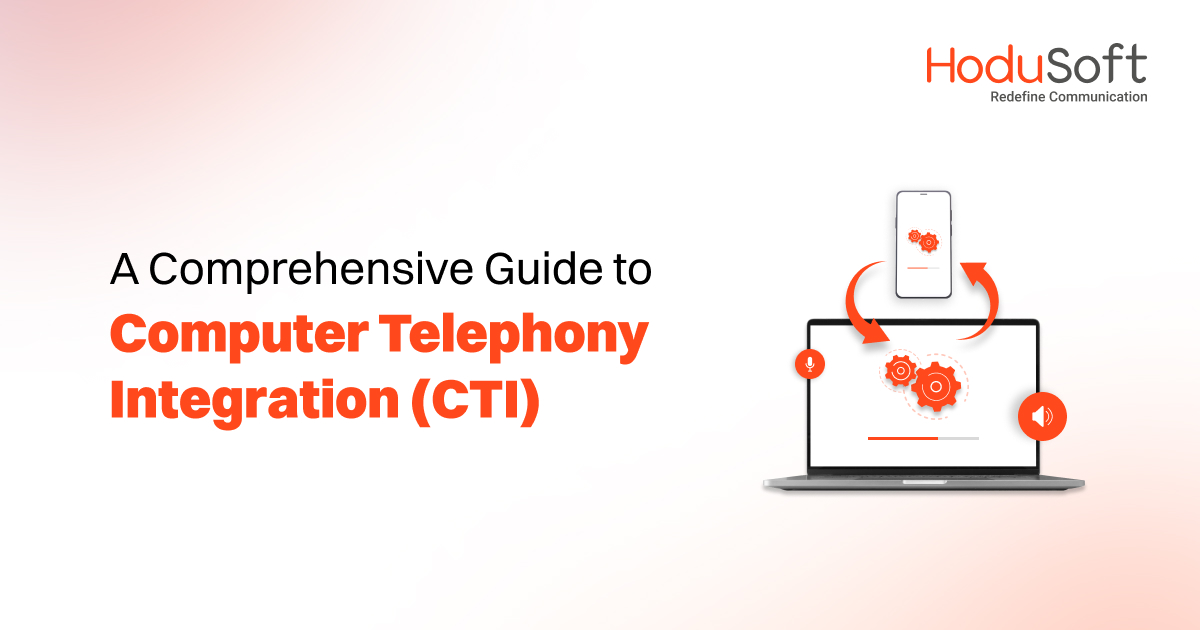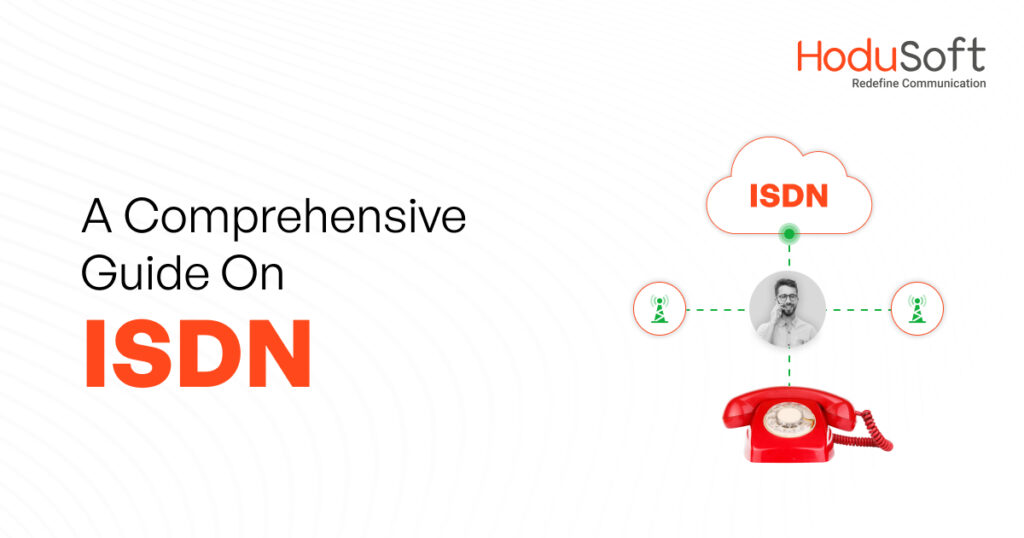What Is Computer Telephony Integration (CTI)? An In-Depth Guide
Does the term “Computer Telephony Integration” ring a bell? If you are in the call center or contact center industry, you must have come across the term at least once.
This blog post covers everything from what is Computer Telephony Integration (CTI for short), history and evolution of CTI, how CTI works, benefits of CTI, types of CTI, features of CTI, and how to handpick the right CTI. Read on to know more.
What Is Computer Telephony Integration?
CTI is a technology using which contact centers and call centers can integrate their telephony and business communication systems with their computer applications. .

CTI is a technology using which contact centers and call centers can integrate their telephony and business communication systems with their computer applications such as:
- Customer Relationship Management (CRM) system
- Ticketing system
- Helpdesk software
- SMS and email blasting platform
- And several other business applications
By leveraging CTI, call center and contact center agents can manage customer interactions more efficiently. They can access essential call management functionalities and customer information, which helps them reduce manual errors.
History and Evolution of CTI Technology
The foundation of CTI was laid by the good-old screen pop technology. In this technology, relevant customer information such as caller ID, Automatic Number Identification (ANI), Dialed Number Identification Service (DNIS), and information from Interactive Voice Response (IVR) system, pops up automatically onto an agent’s computer screen just at the same time the agent picks up the customer’s call.
After the screen pop technology started gaining widespread adoption in markets like North America and West European countries, many organizations, ranging from the government-controlled ones to their private-run counterparts, started working on the CTI technology.
Key standards like the Computer-Supported Telecommunications Application (CSTA), the Java Telephony API (JTAPI), the Telephony Server API (TSAPI), and the Telephony Application Programming Interface (TAPI) normalized CTI interfaces. Lucent and IBM played significant roles, but startups like ZTEL also contributed innovative solutions.
Digital Equipment Corporation and Tiger Software developed middleware solutions. By 2008, PBX vendors aligned with standards like TAPI, CSTA, or TSAPI. Hardware saw a shift with emerging IETF standards, bringing in players like Dialogic and Aculab. From 2011, independent handsets with SIP connectivity led to handset vendors incorporating CTI support, with uaCSTA becoming popular by 2016.
In the present time, CTI technology has evolved from proprietary to standardized solutions as both software and hardware innovations shape its development. As per a report released by Business Research Insights, the global CTI software market size is estimated to grow at a compound annual growth rate (CAGR) of 17.8 percent from USD 2071.7 million in 2022 to USD 5547.4 million by 2028.
How Does CTI Work?
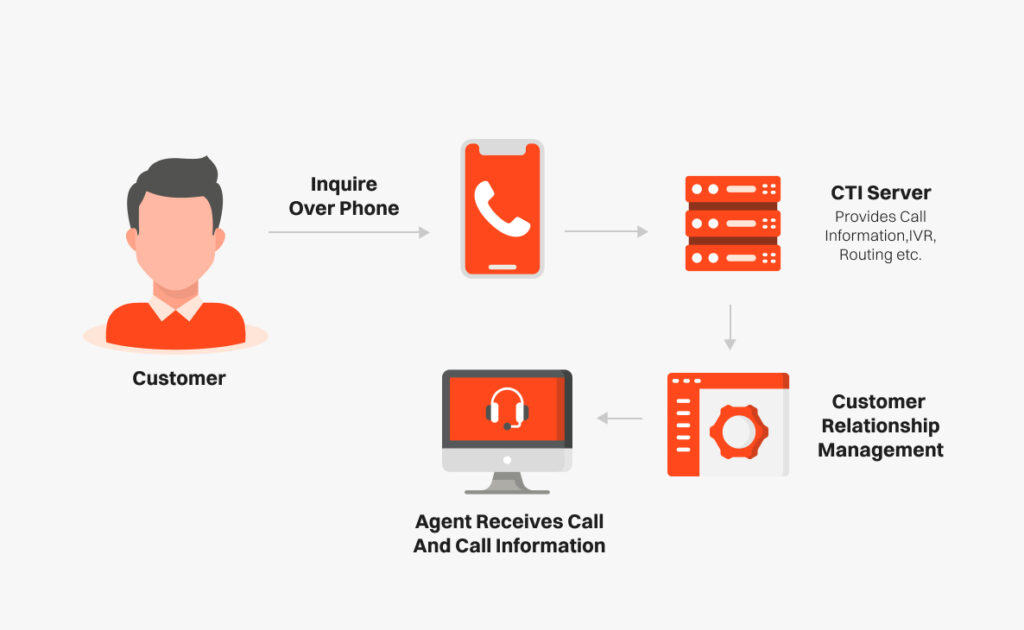
In a sophisticated call center or contact center, whenever an agent receives a call they are able to see relevant customer information on their screen at the very same moment. That’s CTI in action.
CTI bridges the gap between an organization’s phone (business communication) system and their range of business applications. That facilitates seamless data flow between two different systems and enhances the flow of communication.
In the event of an incoming call, the business communication (or telephony) system transmits data (such as the caller’s phone number) to the CTI software. After that, the data triggers actions within the computer applications.
By converting computer into a virtual phone extension, Voice over Internet Protocol technology simplifies integration. After connecting, CTI synchronizes data between computer and phone system. For instance, a sophisticated CTI system can retrieve customer’s information on the agent’s screen as soon as they receive an incoming call (known as screen pop). That enables the agents to greet callers by name and access their details.
Benefits of CTI
CTI, or Computer Telephony Integration, offers numerous benefits for businesses, particularly those focused on customer service and communication. Here are some top benefits of CTI:

1. Enhanced Customer Experience
By providing context-rich information to agents before they even answer a call, CTI enables smoother interactions between customers and agents. CTI also allows for:
- Faster call resolution
- Personalized service
- Self-service options
Apart from leading to happier customers, it results in faster query resolution and superior customer experience.
2. Increased Efficiency
By integrating telephony systems with computer systems, CTI automates repetitive tasks, such as call routing and data entry, reducing the time agents spend on administrative tasks and allowing them to focus more on customer interaction.
3. Improved Productivity
With CTI, agents have access to customer information in real-time. Better phone controls and features like screen pops and call routing free up agents’ time to handle more calls and resolve issues more efficiently. It enables agents to provide personalized service and resolve issues more efficiently. This results in higher productivity levels for the contact center.
4. Cost Savings
CTI helps organizations save money by streamlining processes and reducing the need for manual intervention. It also optimizes call routing, minimizing call handling times and ultimately reducing operational costs.
5. Better Reporting and Analytics
CTI systems capture data from each customer interaction, providing valuable insights into call volumes, agent performance, customer behavior, and trends. This data can be used to make informed decisions and improve overall business strategies.
6. Integration with CRM Systems
CTI seamlessly integrates with Customer Relationship Management (CRM) systems, allowing agents to access customer data and interaction history in one centralized location. This integration improves service quality and enables personalized interactions.
7. Scalability
CTI solutions are highly scalable and can adapt to the changing needs of businesses, whether they’re expanding their operations or downsizing. This scalability ensures that organizations can maintain high-quality customer service regardless of their size.
8. Multi-Channel Support
Many CTI systems support multiple communication channels, such as voice calls, emails, and live chat. This enables businesses to provide consistent support across various platforms, catering to the preferences of different customer segments.
9. Compliance and Security
CTI solutions often come with built-in security features to protect sensitive customer data and ensure compliance with industry regulations such as GDPR or HIPAA. This helps organizations maintain trust and credibility with their customers.
10. Competitive Advantage
By leveraging CTI to deliver exceptional customer service and optimize operational efficiency, businesses can gain a competitive edge in their industry. Providing a seamless, personalized customer experience sets them apart from competitors and fosters customer loyalty.
Types of CTI Technology
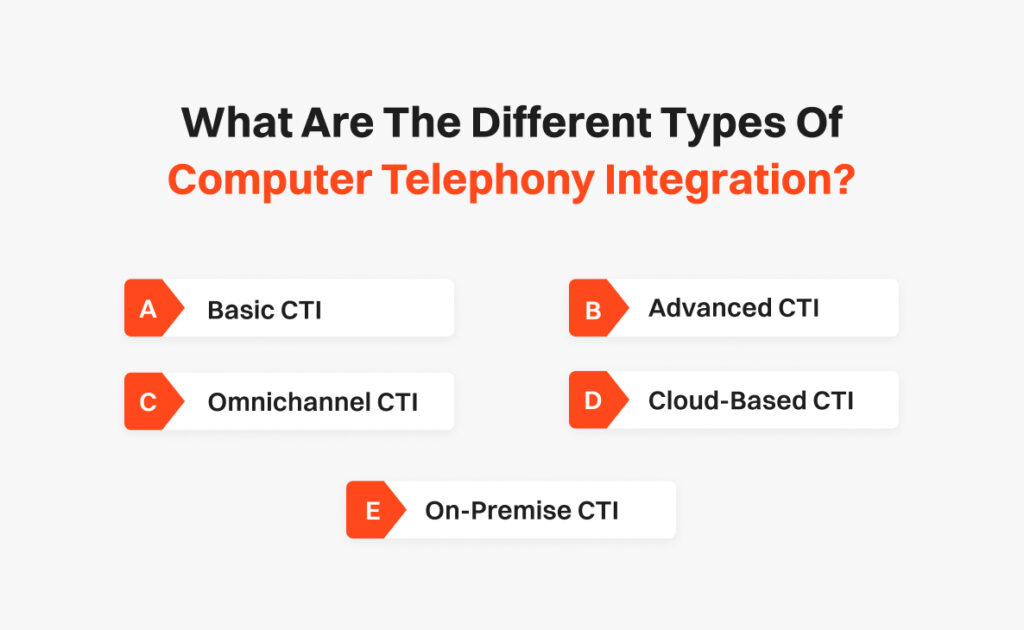
Computer Telephony Integration (CTI) encompasses a variety of technologies that enable the integration of telephony systems with computer systems to enhance communication and streamline business processes. Here are some common types of CTI technologies:
1. Softphone CTI
Softphone CTI is ideal for cloud-based contact centers, in which customer service representatives use softphones instead of traditional desk phones. This type of CTI enables a wide range of features within the softphone interface, such as:
- Accessing call details
- Managing call availability
- Logging into call queues
- Facilitating screen pops
- Enabling click-to-call functionality
2. Hardware-based CTI
Hardware-based CTI involves using physical equipment to facilitate communication between computer systems and telephone networks, for instance integrating desk phones with CRM systems. This type of CTI typically entails specialized hardware components such as:
- Telephony interface cards
- Connection between computers and phone lines
- Devices like telephones, headsets, and other peripherals
- High-end call center headsets with built-in call controls
3. Cloud-based CTI
Cloud-based CTI refers to the integration of telephony services with cloud-based software applications. Unlike traditional hardware-based CTI solutions, cloud-based CTI leverages internet connectivity and cloud infrastructure to deliver telephony features and functionality. This type of CTI has the following features:
- Displaying caller information from CRM records upon receiving a call
- Skills-based routing, connecting callers with the most suitable agent based on customer data
- Creating new CRM entries
- Using Natural Language Processing (NLP) to interpret call notes and schedule follow-up tasks
4. Omnichannel CTI
Omnichannel CTI seamlessly integrates various communication channels into a unified interface or platform. The various communication channels are:
- voice calls
- video calls
- emails
- chat messages
- social media interactions
It empowers agents to simultaneously handle multiple customer interactions irrespective of the channel.
5. On-Premise CTI
On-premise CTI entails deploying and managing computer telephony infrastructure within an organization’s own physical premises and local network instead of relying on cloud-based or hosted solutions. This type of CTI needs require hardware and software installations on the customer’s infrastructure. Here are some key aspects of on-premise CTI:
- Hardware infrastructure
- Software applications
- Integration with phone systems
- Customization and control
- Security and compliance
6. Serverless CTI
As the name suggests, serverless CTI runs operates without dedicated infrastructure or servers. This type of CTI relies on cloud-based infrastructure provided by third-party service providers. By enabling users to pay for their actual usage, this pay-as-you-go model offers organizations a flexible, scalable, and cost-effective approach to integrating their communication system with their business applications.
7. Browser-Based CTI
Browser-based CTI enable the integration of telephony and computer systems via web browser. This integration enables users to make and receive calls, send messages, and manage call-related data directly from the browser. This CTI type eliminates the need for additional hardware and software installations as well as eliminates the need to switch to a separate phone application.
Features of CTI
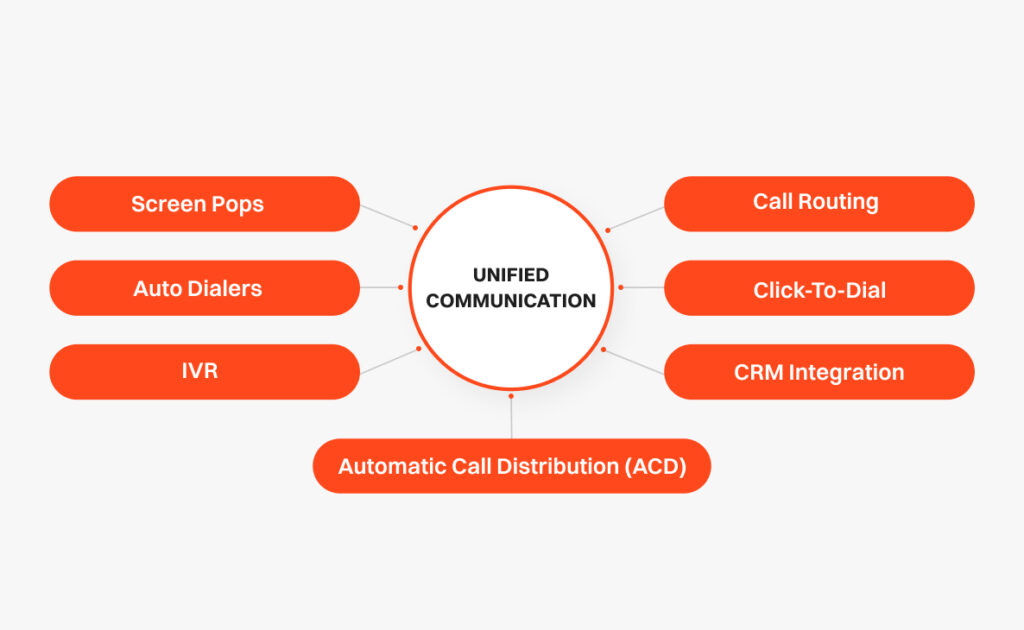
CTI technology encompasses a wide range of features designed to enhance communication capabilities and streamline business processes. Here are some common features associated with CTI systems:
1. Screen pops
As discussed earlier, screen pops laid the foundation of CTI technology. And screen pops indeed are among the major features of CTI. As soon as a call connects, screen pops automatically appear on the agent’s screen and show all relevant customer information such as:
Name
Past purchases
Transaction history
Support tickets
2. Auto dialers
Auto dialers are among the most important features of CTI for those organizations that make outbound calls. By accessing the contact list in the CRM system and other business applications, CTI dials the numbers in the pre-defined lists automatically.
3. IVR
CTI systems often include IVR capabilities, allowing callers to interact with automated menus using voice commands or keypad inputs. IVR systems can route calls to the appropriate destination, collect caller information, and provide self-service options for common inquiries.
4. Call routing
CTI systems allow users to control phone calls directly from their computers or other digital devices. This includes making outbound calls, answering incoming calls, transferring calls, and ending calls.
5. CRM integration
Integration with Customer Relationship Management (CRM) systems is a key feature of many CTI solutions. This integration allows agents to access customer information, call history, and other relevant data directly from within the CTI interface.
6. Click-to-Dial
CTI systems often support click-to-dial functionality, allowing users to initiate outbound calls by clicking on phone numbers within CRM systems, contact lists, or web browsers. This simplifies the calling process and reduces dialing errors.
7. Automatic Call Distribution (ACD)
ACD functionality in CTI systems automatically routes incoming calls to the most appropriate agent or department based on predefined criteria, such as the caller’s language preference, IVR (Interactive Voice Response) selections, or agent availability.
How to Handpick the Right CTI for Your Call/Contact Center?
If you run a call/contact center you will need to make sure that the money you invest in acquiring a CTI technology/feature is the right one for your business. As John C. Maxwell famously said, “Life is a matter of choices, and every choice you make makes you.”
Here are some ways by which you can handpick the right CTI for your call/contact center.
1. Assess Your Needs
Before you start anything, you need to assess your needs. Ask questions like “Why do you need a CTI in the first place?” “What problems is it going to solve?” “What should be the size and scope of the integration?”
Identify the specific requirements and challenges of your call/contact center. Ask how CTI can address these needs. Can CTI enhance call routing and customer experience? Can it reduce call handling time? Can it improve your contact center’s efficiency? If the answer to all the questions is a ‘yes,’ you must consider investing in sophisticated CTI technology.
2. Handpick the Right CTI Technology
Now that you have determined your needs, it’s time to look for the right CTI provider in and around your area of operations. Type some high-intent search terms and evaluate the CTI solution based on the following:
- Pricing plans: Is the CTI solution within your budget?
- Integrations: Can the CTI solution integrate with the existing business applications?
- Customer reviews: What customers are saying about the CTI and what’s the rating it has received?
- Free trial: Is the software solution provider willing to provide free demo?
If the answer to all the above questions is a ‘yes’ then that may be the CTI you are looking for.
3. Implement the CTI
Develop a detailed implementation plan by outlining the installation process, data migration strategy, and a comprehensive training schedule for your call center agents.
You can automate the process by leveraging advanced software solutions that streamline data migration and automate the installation process. Additionally, integrating robust training modules into your implementation plan can ensure seamless adoption by your call center agents.
All in All,
In today’s fast-paced business landscape, efficient communication is non-negotiable. Computer Telephony Integration (CTI) emerges as the game-changer, bridging the gap between your phone system and computer applications to streamline customer interactions.
From enhancing customer experiences to boosting agent productivity and driving cost savings, the benefits of CTI are undeniable. By leveraging the power of CTI, businesses can stay ahead of the curve, delivering personalized service and optimizing call center operations.
As technology continues to evolve, the future of CTI holds even more promise, with advancements like cloud-based integrations and natural language processing paving the way for unparalleled efficiency and innovation.

